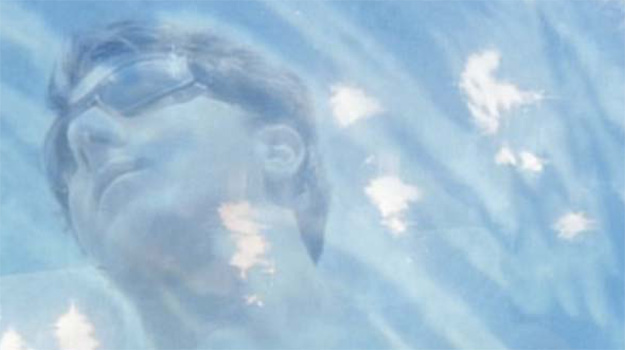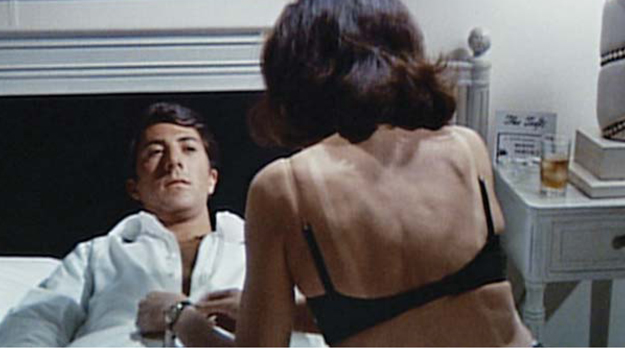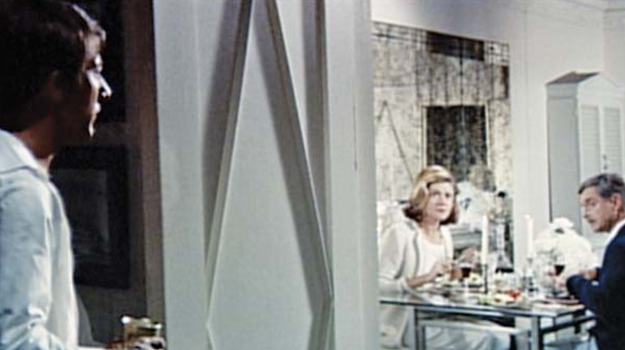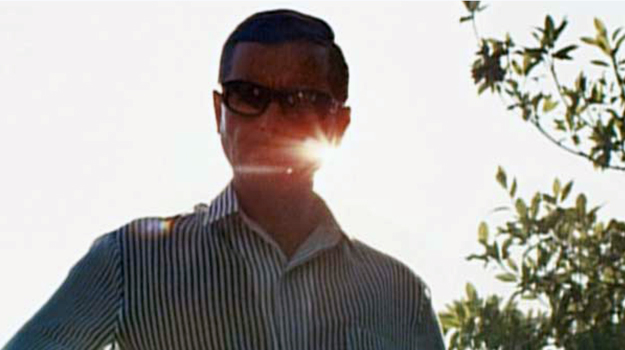BY ROB FELD
The Graduate was released in 1967 in the eye of America’s radical cultural shift led by the country’s alienated youth. Directing his second feature, Mike Nichols unwittingly found himself with a zeitgeist movie and an instant hit. The film’s anti-hero, Benjamin Braddock(Dustin Hoffman), drifts from his post-college life at home with his parents to an affair in a hotel room with their best friend, Mrs. Robinson (Anne Bancroft). Nothing holds meaning for him and he has become passive and numb as he contemplates his future. It’s a highly subjective film with everything filtered through the eyes of its protagonist. What is probably only a few months in real time passes timelessly in Nichols’ iconic, illusory montage famously accompanied by Simon and Garfunkel’s score. “We very consciously thought of the movie as a dream, and just beginning to wake up from it at the very end,” says Nichols, who, with screenwriter Buck Henry, planned from the early writing stages the complex sequence that encompasses most of Benjamin’s affair with Mrs. Robinson.
Nichols also worked with production designer Richard Sylbert to design and build the interior of Benjamin’s home and the hotel room to match each other in ways that would allow clever cuts and framing to disguise the transitions between locations. “We did a lot of fancy camera shit,” says Nichols, “but nobody has ever mentioned it in 40 years because if you have events that are compelling you’re completely unaware of what the camera is doing, which is the idea.” The result is a fluid journey through Benjamin’s psyche, perfectly translating his troubled state of mind to images on the screen.

‘Hello darkness,’ the opening line from Simon and Garfunkel’s ‘The Sounds of Silence,’ starts over a black screen and the pool fades in. [Screenwriter] Buck Henry and I knew we didn’t want a realistic picture and the most surreal thing in it is this montage, covering not only a lot of time but inner time. We had a filter that was crosshatched to cause those little sparkles in the water. We called it ‘Sparkle Plenty.’ The water wasn’t lit or colored; it’s all filter and sunlight, and I think we had guys doing that pedaling-thing to move the water. We shot a half-hour of water, and after 10 minutes of watching dailies, Larry Turman, the producer, said, ‘I think the small ones are winning.’

We faded into Dustin and then cross-dissolved into all the shots of him on the diving board, over the water. I just said, ‘Do various things, let me see you turn, let me see you turn slow,’ and then we put it together in the cutting room. I think we overcranked some of his moves—I don’t know which we used because the dissolves are very long and he’s moving in some of them. I always wanted to leave as much water in the frame as I could because it was about the nowhereness of Benjamin’s experience. Seeing just him wouldn’t have been as expressive of that. It was the prison as well as the prisoners.

The house was chosen for the pool and the outside. We used long lenses for almost everything—150 mm or more. Dustin looked much better with a long lens (as we all do) and it took some of the reality out. We’re set up against the bushes of the pool. My idea was that the whole thing was about a kid who’s battling passivity. He’s surrounded by and drowning in objects in his middle-class family, in a super middle-class environment. He is expressionless because he’s desperately trying not to become an object, which you see from the first frame.

Here it looks like Benjamin is entering his house and we cut to inside the Taft Hotel set. It took us a good week, maybe two, to talk through this montage. What I realized very early was that if this idea was going to work, you could not know where he was in the next place, so that it’s truly seamless. And that’s what we did. It was simply matching, matching, matching, matching. You have to do two places that match. Everything had to hide the fact that we’re going to be in another place until you see, Oh, look, it’s another place.

So this is the Taft Hotel, which is a set. I wanted it to match the last shot exactly—the lighting, the camera level are the same; we measured all that. Dustin goes in one size in one shot, comes out in the next. Maybe we cheated in the cutting room, we’re a little closer. This was all storyboarded, for obvious reasons, and I got Richard Sylbert, the production designer, to draw it up to see what the hotel and home sets would have to have in common to be able to do the back and forth between Mrs. Robinson in the hotel and Benjamin’s house.

We panned and tracked to get him to the bed. We’re still fairly far back on the set with the zoom. Basically the look of the picture is that zoom. I think we used it on almost everything. It’s constantly moving in and out. It also helped the match enormously because we didn’t have to switch lenses. We were just setting on the zoom that worked. I wanted to express the despair of an affair that is just below the waist and he has no real connection to it, so the montage is how it goes on once conversation fails. It’s quite extreme but it needs to be. There is no interpersonal interaction. It’s not just for good taste that we skipped the sex.

Dustin and I understood each other about Ben’s inexpressiveness, which was his particular gift. He was good at the depersonalization of the character, he knew about it. And we rehearsed and rehearsed. Dustin kept saying we could have done it on Broadway we had rehearsed so much, but not just doing the scenes. We improvised their relationship with the other family when they were little, and around the pool. We explored all that shit. We knew everything about it by the time we were shooting because we knew we had to shoot very fast. The lighting was all bread and butter. That was [DP Robert] Surtees. He just automatically did that.’

We pan with him and, obviously, he’s shutting his parents out. He’s living apart from them in their house, but he’s also living apart from Mrs. Robinson in the hotel room. Both the house and hotel sets were meant to be as blank as possible. I wanted emptiness in these places and I didn’t want them to have a lot of characteristics. I just wanted what it was to him. What guy would see the décor anyway? It has no meaning, it’s just blank. We see him having no pleasure, not seeing any of the beauty in the world.

The camera stays stationary on Ben until Mrs. Robinson leaves. She goes through the frame, back and forth, which I planned months before with Buck because I wanted to see this for the matching. The light is supposed to be coming from the television; the idea is that he’s pulled into it. To get Ben’s reflection, the mirror is in a completely idiotic place. We moved it and the bureau right next to the door so we could get him and not have to cut. The ‘slam’ when the door closes behind Mrs. Robinson is the only time you hear sound, and that had to be because it lands him at home on the cut. Sam O’Steen and I found that while editing.

Benjamin has walked out of the last shot at home and I wanted him to walk into this one. We didn’t pan to him here. This moment is about his mother’s despair; it looks like exasperation, but it’s despair nevertheless, just like everyone else’s. His mother’s hair, the way he doesn’t look at her, everything, it’s all like Mrs. Robinson. He’s totally alienated from everybody, just short of disturbed. And the design is the same grid. The camera stays stationary as he gets smaller, going on his senseless journey and diving into the pool.

We were set up in the water and he jumps in and swims. The color just happened by itself. In fact, I was miserable about it for weeks because the water looked cloudy. Katharine [Ross] had busted Dustin’s eardrum, hitting him in the scene in which she realizes he’s had an affair with her mother, so we had a hard time when he was diving. He had all sorts of plugs and things to protect his eardrum. He just swam toward the camera. Again, it was storyboarded and I knew exactly what I wanted. I wanted him underwater, I wanted to see him coming out, landing on Mrs. Robinson and the raft at the same time—cut, cut.

This was from poolside with the zoom, the song ended right here. [At first] I couldn’t figure out the score and my brother sent me that Simon and Garfunkel record. I thought, ‘Holy shit! This is my score!’ We just dropped in ‘Hello Darkness’ and we were beside ourselves! It was terrifying how it fit. And then we added ‘April Come She Will.’ The miracle of that song fitting is that it’s about time passing and losing love—the additional coincidence seemed almost impossible. I have a theory that when something is working, when it is in tune with itself, with the people doing it and the world around it, it becomes a kind of magnet that draws the right things to it.

You kind of see Mrs. Robinson’s face in the hotel room as she’s passing by, but here is the first time you really see it, and she’s checked out. It’s what she was after: oblivion. And then Benjamin hears his father’s voice: ‘Ben, what are you doing?’ and he looks up. I wanted a moment here. I didn’t want to say: He’s on the raft! Are we cute or what? It’s that thing you decide when you’re editing—you don’t know until that moment if you like something better than the other way. Sometimes it’s as simple as that. And this could all be his fantasy until we cut back to the raft.

This is Ben looking up at his father from the pool. We were on a hard lenses here, about 150 mm for the singles. Shooting into the sun was something we found and it was a tremendous help; it wasn’t preplanned. The sun makes his father kind of godlike—he has all this power and has nothing in his head at all. I think it was Surtees who said there was time on the day to shoot everything into the sun. It was so surreal, Ben couldn’t quite see his father. I was very happy with that. Surtees was a great DP and I learned a lot from him. That sun thing was the perfect ending for this scene.